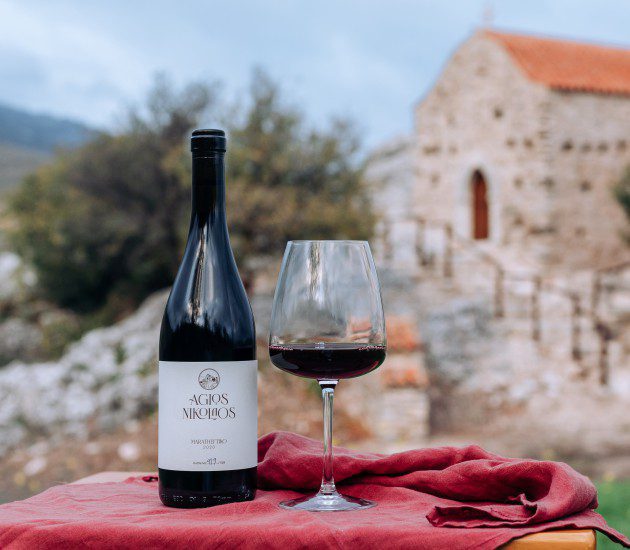Maratheftiko, a rare indigenous grape variety from Cyprus, has captivated wine enthusiasts with its distinctive character and historical significance in the island’s viticulture. This ancient variety, once nearly forgotten, has experienced a remarkable revival thanks to dedicated Cypriot winemakers who recognized its potential to create complex, age-worthy wines that truly express the Mediterranean terroir.
Key Takeaways
- Maratheftiko is a female-only flowering grape that requires co-planting with other varieties for successful pollination
- Despite covering less than 1% of Cyprus’s vineyards, it produces wines with exceptional color and tannin structure
- The variety faced near-extinction before being revived by boutique wineries in the 1980s
- Maratheftiko wines typically feature notes of dark berries, violet, and earthy tones
- Its natural drought tolerance makes it increasingly valuable in the face of climate change
The Historical Journey of Maratheftiko
Maratheftiko’s roots trace back over a millennium, with evidence suggesting cultivation during the Byzantine era. The name likely comes from the village of Marathos, one of its traditional growing regions. By the late 19th century, French botanist Pierre Mouillefert had already documented the grape’s
susceptibility to mildew and uneven ripening, factors that contributed to its decline.
For much of the 20th century, Maratheftiko served primarily as a blending component with the more common Mavro grape. Its purpose was to enhance color and structure in wines, as its
low yields made it economically challenging for mass production. This limited role nearly pushed the variety into obscurity.
The 1980s marked a turning point when boutique wineries began rediscovering Maratheftiko’s potential. Pioneers like Zambartas Wineries and KEO Winery invested in research to address its cultivation challenges, leading to a
gradual increase in plantings across the island.

Unique Viticultural Challenges
Unlike most wine grapes, Maratheftiko cannot self-pollinate due to its female-only flowers. Successful fertilization requires
co-planting with hermaphroditic varieties like Spourtiko or Xynisteri that bloom simultaneously. This dependency complicates vineyard management and increases costs, as 10-15% of a Maratheftiko vineyard must be dedicated to pollinator vines.
Up to 40% of Maratheftiko clusters exhibit millerandage—a condition where berries vary in size and maturity. This uneven ripening reduces yields to about
4-6 tons per hectare and requires careful sorting during harvest. Interestingly, studies suggest that this condition may actually enhance flavor concentration, as smaller berries have a higher skin-to-juice ratio.
Research highlights Maratheftiko’s resilience to moderate drought stress, which increases
phenolic compounds in the berries. Modern vineyards now employ no-till farming and controlled irrigation to optimize quality in Cyprus’s increasingly warm climate, making this variety particularly valuable for
quality wine production.
Distinctive Wine Profile
Maratheftiko produces wines with remarkable structural characteristics, typically exhibiting alcohol levels of 13-14.5% ABV, acidity of 5.5-7.7 g/L tartaric acid, and
firm, chalky tannins that soften beautifully with age. Young wines display primary notes of sour cherry, raspberry, and violet.
With oak aging (commonly 8-12 months in French barrels), secondary flavors of dark chocolate, coffee, and vanilla emerge. A 2020 study identified
31 distinct anthocyanins in Maratheftiko—more than in other Cypriot reds—contributing to its deep color and antioxidant properties.
High-quality examples can age gracefully for 8-12 years. The University of Nicosia’s analysis found that Maratheftiko’s phenolic content (2,800-3,200 mg/L GAE)
surpasses even Cabernet Sauvignon grown in similar Mediterranean climates, explaining its excellent aging potential.
Notable Producers and Regions
Several wineries have become synonymous with exceptional Maratheftiko wines across the
different wine regions of Cyprus. Makarounas Winery in Paphos produces a 100% Maratheftiko wine aged in 300L French oak. The 2021 vintage features
black-olive and sour-cherry notes, with a structure reminiscent of Sangiovese.
Ktima Anaxagora creates an organic Maratheftiko from Pachna’s limestone soils, offering dark berry and smoky aromas after 9-12 months in oak. Fikardos Winery, a leader in reviving indigenous varieties, emphasizes
floral aromas and balanced tannins in their expression, reflecting the unique terroir of the Troodos Mountains.
Today, Maratheftiko accounts for 5-7% of Cyprus’s cultivated vineyards, with concentrations in the Pitsilia region and the Paphos villages of Vouni Panayia and Ambelitis. These areas provide the
ideal growing conditions for this challenging but rewarding variety.
Growing International Recognition
The establishment of International Maratheftiko Day in 2023, celebrated on December 1st, has spurred exports to the EU, Japan, and the UK. Decanter’s awards have highlighted several Maratheftiko wines, noting their
“refreshing acidity and aging potential” as standout qualities.
While entry-level bottlings retail for €15-20, premium examples command €25-30 per bottle. The UK’s Wine Society reports a 45% increase in Cypriot wine sales since 2020, driven largely by interest in Maratheftiko and other
prestigious Cypriot wine brands.
The Cyprus Ministry of Agriculture’s 2025-2030 viticulture plan allocates €2 million for
clonal selection programs to address pollination and yield issues. Early trials of hermaphroditic clones show promise, with 20% higher yields in experimental plots.
Future Prospects
Maratheftiko’s drought tolerance positions it as a climate-change-resistant variety. Projections suggest its cultivation could expand beyond Cyprus to Crete and southern Italy by 2035, making it
increasingly relevant in Mediterranean viticulture.
Debates continue between traditionalists advocating for field blends and modernists pushing single-varietal expressions. As winemaker Sofia Vassiliou notes: “Maratheftiko isn’t just a grape—it’s a
narrative of Cyprus’s past and future.”
For wine enthusiasts seeking authentic expressions of place and history, Maratheftiko offers a compelling taste of Cyprus’s sun-drenched terroir. Its journey from near obscurity to international acclaim underscores the island’s evolving wine identity and the value of preserving indigenous varieties.
Sources
Wikipedia – Maratheftiko
Vinerra – Discover the Maratheftiko Grape: A Unique Cypriot Treasure
Cyprus Mail – All About Maratheftiko
Gabi Zimmer – Maratheftiko Native Red Variety in Cyprus
Annabelle – The Maratheftiko Grape Variety of Cyprus
The Wine Society – Maratheftiko Makarounas Winery 2021
Decanter – International Maratheftiko Day: Awarded Wines to Try 






